Evaluating the Accuracy of a Gridded Near-Surface Temperature Dataset over Mainland China
Abstract
1. Introduction
2. The Climate of Mainland China
3. Data and Methods
3.1. Meteorological Data Sets
3.2. Methods
3.2.1. Evaluating Indices
3.2.2. Root Mean-Square Error
3.2.3. Correlation Test
3.2.4. Climate Trend Analysis
4. Results
4.1. Evaluation of Daily Temperature Data
4.1.1. RMSE of Daily Temperature
4.1.2. Climate Trend of Daily Temperature
4.2. Evaluation of Monthly Temperature Data
4.2.1. RMSE of Monthly Temperature
4.2.2. Climate Trend of Monthly Temperature
4.3. Evaluation of Annual Temperature Data
4.3.1. RMSE of Annual Temperature
4.3.2. Climate Trend of Annul Temperature
4.4. Evaluation of Thermal Resources
4.4.1. Evaluation of the Frost-Free Period, First and Last Frost Day
4.4.2. Evaluation of Active Accumulated Temperature
5. Discussion
5.1. Evaluating Universal Temperature Elements
5.2. Evaluating Agricultural Thermal Resources
5.3. Statistic Test on Climate Trend
6. Conclusions
Supplementary Materials
Author Contributions
Funding
Acknowledgments
Conflicts of Interest
Appendix A
References
- Qian, J.X.; Zhang, J.X.; Li, N.; Han, P. Variation characteristics of agricultural heat resource and its effect on agriculture in Shanxi Province, China. Chin. J. Appl. Ecol. 2015, 26, 786–792. [Google Scholar]
- Reddy, P.P. Climate Resilient Agriculture for Ensuring Food Security; Springer India: Pune, Maharashtra, India, 2015; pp. 154–196. [Google Scholar]
- Zhang, X.T.; Pan, X.B.; Xu, L.; Wei, P.; Hu, Q.; Yin, Z.W.; Shao, C.X. Spatio-temporal variation of agricultural thermal resources at different critical temperatures in China’s temperate zone. Res. Sci. 2017, 39, 2104–2115. [Google Scholar]
- Yang, P.Y.; Hu, Q.; Ma, X.Q.; Hu, L.T.; Ren, F.Y.; Yan, M.L.; Huang, B.X.; Pan, X.B.; He, Q. Spatiotemporal Variation of Heat and Solar Resources and Its Impact on Summer Maize in the North China Plain over the Period 1961–2015. Chin. J. Agrometeorol. 2018, 39, 431–441. [Google Scholar]
- Hayhoe, K.; Wake, C.P.; Huntington, T.G.; Luo, L.; Schwarta, M.D.; Sheffield, J.; Wood, E.; Anderson, B.; Bradbury, J.; De Gaetano, A.; et al. Past and future changes in climate and hydrological indicators in the US Northeast. Clim. Dyn. 2007, 28, 381–407. [Google Scholar] [CrossRef]
- Kirby, E.J.M.; Appleyard, M.; Fellowes, G. Effect of sowing date on the temperature response of leaf emergence and leaf size in barley. Plant Cell Environ. 2010, 5, 477–484. [Google Scholar] [CrossRef]
- Wang, Y.Y.; Zhang, B. Characteristics of frost days and accumulated temperature in eastern Gansu over the last 40 years. Res. Sci. 2012, 34, 2181–2188. [Google Scholar]
- Mccabe, G.J.; Betancourt, J.L.; Feng, S. Variability in the start, end, and length of frost-free periods across the conterminous United States during the past century. Int. J. Climatol. 2016, 35, 4673–4680. [Google Scholar] [CrossRef]
- Li, X.H.; Xu, Y.L.; Meng, C.C.; Zhang, L.; Wang, C.G. Analysis on the Changes of Agro-Meteorological Thermal Indices in Northeast China under RCP4.5 Scenario Using the PRECIS2.1. Atmosphere 2018, 9, 323. [Google Scholar] [CrossRef]
- Kalany, E.; Kanamitsu, M.; Kistler, R.; Collins, W.; Deaven, D.; Gandin, L.; Iredell, M.; Higgins, W.; Janowiak, J.; Mo, K.C.; et al. The NCEP/NCAR 40-year reanalysis project. Bull. Am. Meteorol. Soc. 1996, 77, 437–471. [Google Scholar] [CrossRef]
- Kistler, R.; Kalnay, E.; Collins, W.; Saha, S.; White, G.; Woollen, J.; Chelliah, M.; Ebisuzaki, W.; Kanamitsu, M.; Kousky, V.; et al. The NCEP/NCAR-50 year reanalysis: Monthly means CD-ROM and documentation. Bull. Am. Meteorol. Soc. 2001, 82, 247–267. [Google Scholar] [CrossRef]
- Guiot, J.; Boreux, J.J.; Braconnot, P.; Torre, F. Data-model comparison using fuzzy logic in paleoclimatology. Clim. Dyn. 1999, 15, 569–581. [Google Scholar] [CrossRef][Green Version]
- Simmons, A.J.; Gibson, J.K. The ERA-40 Project Plan; ERA-40 Project Report Series; ECMWF: Reading, UK, 2000; pp. 12–24. [Google Scholar]
- Uppala, S.M.; Kallberg, P.W.; Simmons, A.J.; Andrae, U.; Da Costa Bechtold, V.; Fiorino, M.; Gibson, J.K.; HASELER, J.; Hernandez, A.; Kelly, G.A.; et al. The ERA-40 reanalysis. Q. J. R. Meteorol. Soc. 2005, 131, 2961–3012. [Google Scholar] [CrossRef]
- Onogi, K.; Koide, H.; Sakamoto, M.; Kobayashi, S.; Tsutsui, J.; Hatsushika, H.; Matsumoto, T.; Yamazaki, N.; Kamahori, H.; Takahashi, K.; et al. JRA-25: Japanese 25-year re-analysis project-progress and status. Q. J. R. Meteorol. Soc. 2005, 131, 3259–3268. [Google Scholar] [CrossRef]
- Onogi, K.; Tsusui, J.; Koide, H.; Sakamoto, M.; Kobayashi, S.; Hatsushika, H.; Matsumoto, T.; Yamazaki, N.; Kamahori, H.; Takahashi, K.; et al. The JRA-25 Reanalysis. J. Meteorol. Soc. Jap. 2007, 85, 369–432. [Google Scholar] [CrossRef]
- Wu, J.; Gao, X.J. A gridded daily observation dataset over Chinese region and comparison with the other datasets. Chin. J. Geophys. 2013, 56, 1102–1111. [Google Scholar]
- Chaney, N.W.; Sheffield, J.; Villarini, G.; Wood, E.F. Development of a High-Resolution Gridded Daily Meteorological Dataset over Sub-Saharan Africa: Spatial Analysis of Trends in Climate Extremes. J. Clim. 2014, 27, 5815–5835. [Google Scholar] [CrossRef]
- Li, T.; Zheng, X.; Dai, Y.; Yang, C.; Chen, Z.Q.; Zhang, S.P.; Wu, G.C.; Wang, Z.L.; Huang, C.C.; Shen, Y.; et al. Mapping near-surface air temperature, pressure, relative humidity and wind speed over Mainland China with high spatiotemporal resolution. Adv. Atmos. Sci. 2014, 31, 1127–1135. [Google Scholar] [CrossRef]
- Zheng, J.Y.; Bian, J.J.; Ge, Q.S.; Hao, Z.X.; Yin, Y.H.; Liao, Y.M. The climate regionalization in China for 1981–2010. Chin. Sci. Bull. 2013, 58, 3088–3099. [Google Scholar]
- Wang, Y.Z.; Zhang, H.P.; Zheng, D.W.; Dassow, W.V.; Zhang, Z.Q.; Yu, J.X.; Pang, J.J. How a stationary knickpoint is sustained: New insights into the formation of the deep Yarlung Tsangpo Gorge. Geomorphology 2017, 285, 28–43. [Google Scholar] [CrossRef]
- Zheng, D.W.; Zhang, P.Z.; Wan, J.L.; Yuan, D.Y.; Li, C.Y.; Yin, G.M.; Zhang, G.L.; Wang, Z.C.; Min, W.; Chen, J. Rapid exhumation at ~ 8 Ma on the Liupan Shan thrust fault from apatite fission-track thermochronology: Implications for growth of the northeastern Tibetan Plateau margin. Earth Planet. Sci. Lett. 2006, 248, 198–208. [Google Scholar] [CrossRef]
- Chen, B.J. Seismic activity and continental dynamic background in southwestern Guizhou and its adjacent region. J. Geod. Geodyn. 2009, 29, 53–58. [Google Scholar]
- Dai, H.M.; Liu, C.; Gong, C.D.; Cheng, H.X.; Bai, R.J.; Cui, Y.J.; Yang, X.B.; Feng, Y.L. Soil carbon pool in Northeast plain of China and its relations between the soil properties. Quat. Sci. 2013, 33, 986–994. [Google Scholar]
- Wei, F.Y. Modern Climate Statistical Diagnosis and Prediction Technology; China Meteorological Press: Beijing, China, 2013; pp. 290–295. [Google Scholar]
- Zhu, Z.; Shi, C.X.; Zhang, T.; Zhu, C.; Meng, X.Y. Applicability analysis of various reanalyzed land surface temperature datasets in China. J. Glaciol. Geocryol. 2015, 37, 614–624. [Google Scholar]
- Wang, T.Y.; Wu, T.H.; Li, R.; Xie, C.W.; Zou, D.F.; Qian, Y.H.; Yu, W.J.; Wang, W.H. Evaluation of monthly air temperature from two reanalysis datasets in Mongolia. Plateau Meteorol. 2016, 35, 651–661. [Google Scholar]
- Stocker, T.F.; Qin, D.; Plattner, G.K.; Tignor, M.; Allen, S.K.; Boschung, J.; Nauels, A.; Xia, Y.; Bex, V.; Midgley, B.M. Climate Change 2013: The Physical Science Basis; Contribution of Working Group I to the Fifth Assessment Report of the Intergovernmental Panel on Climate Change; Cambridge University Press: Cambridge, UK, 2013. [Google Scholar]
- Liang, H.; Wang, P.J.; Zhang, J.C.; Li, Y.J. Spatial and temporal distribution of variation in heat resource over northeast China during the period from 1960 to 2011. J. Nat. Res. 2014, 29, 466–479. [Google Scholar]
- Han, R.Q.; Li, W.J.; Ai, W.X.; Song, Y.L.; Ye, D.X.; Hou, W. The climatic variability and influence of first frost dates in northern China. Acta Geogr. Sin. 2010, 65, 525–532. [Google Scholar]
- Chen, S.Y. Changes in the first frost date from 1961 to 2009 in Northwest China. Res. Sci. 2013, 35, 165–172. [Google Scholar]
- Zhang, S.Q.; Pu, Z.C.; Li, J.L.; Xu, W.X.; Wang, M.Q.; Zhao, S.Q. The impact of global warming on frost-free periods from 1961 to 2010 in Xinjiang. Res. Sci. 2013, 35, 1908–1916. [Google Scholar]
- Wahba, G. Spline Models for Observational Data; CBMS-NSF Regional Conference Series in Applied Mathematics; SIAM: Siam, Thailand, 1990; Volume 59, p. 169. [Google Scholar]
- Zheng, X.; Basher, R. Thin-plate smoothing spline modeling of spatial climate data and its application to mapping south pacific rainfalls. Mon. Weather Rev. 1995, 123, 3086–3102. [Google Scholar] [CrossRef]
- Saha, S.; Moorthi, S.; Pan, H.L.; Wu, X.; Wang, J.; Nadiga, S.; Tripp, P.; Kistler, R.; Woollen, J.; Behringer, D. The NCEP climate forecast system reanalysis. Bull. Am. Meteorol. Soc. 2010, 91, 1015–1058. [Google Scholar] [CrossRef]
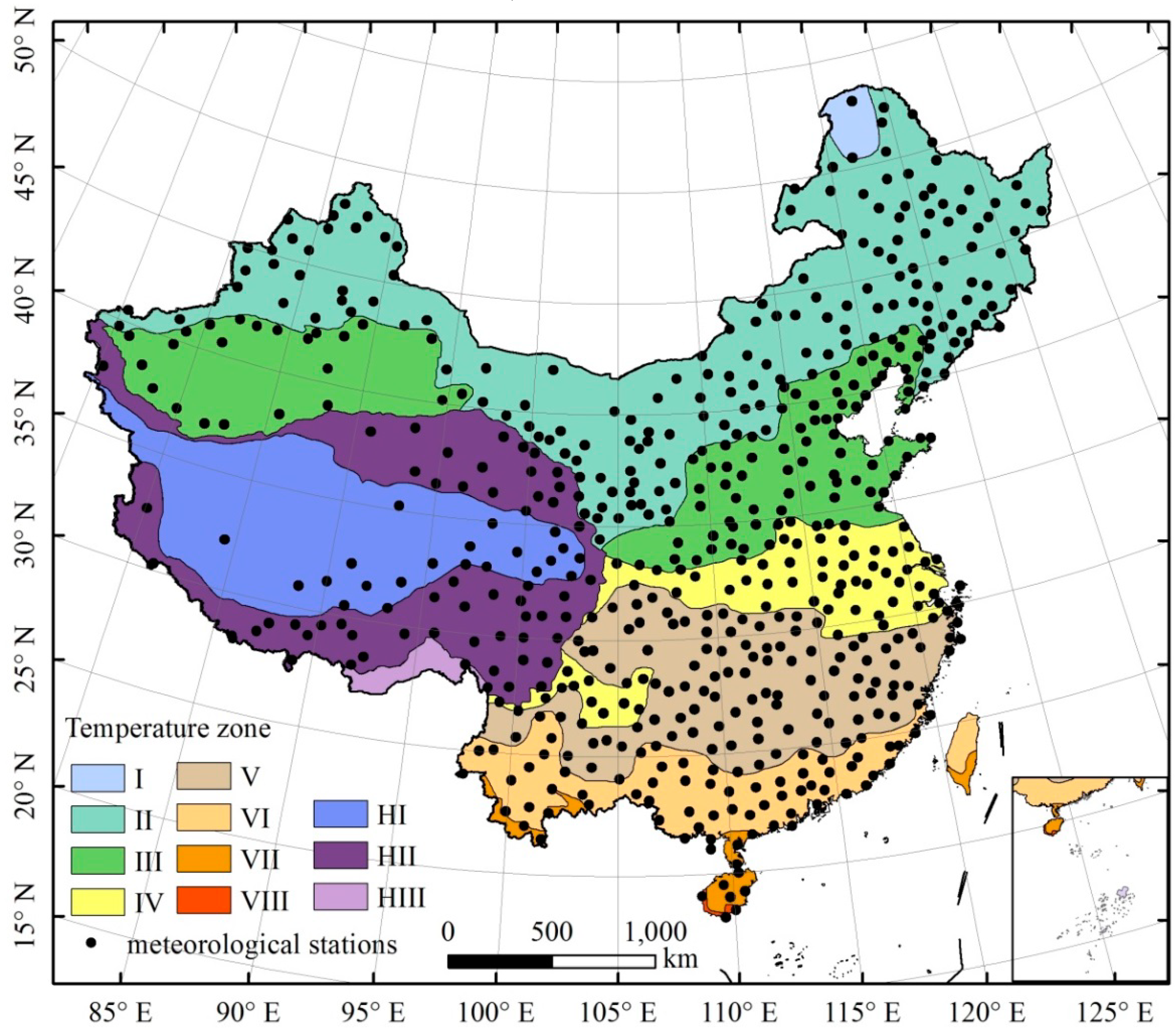
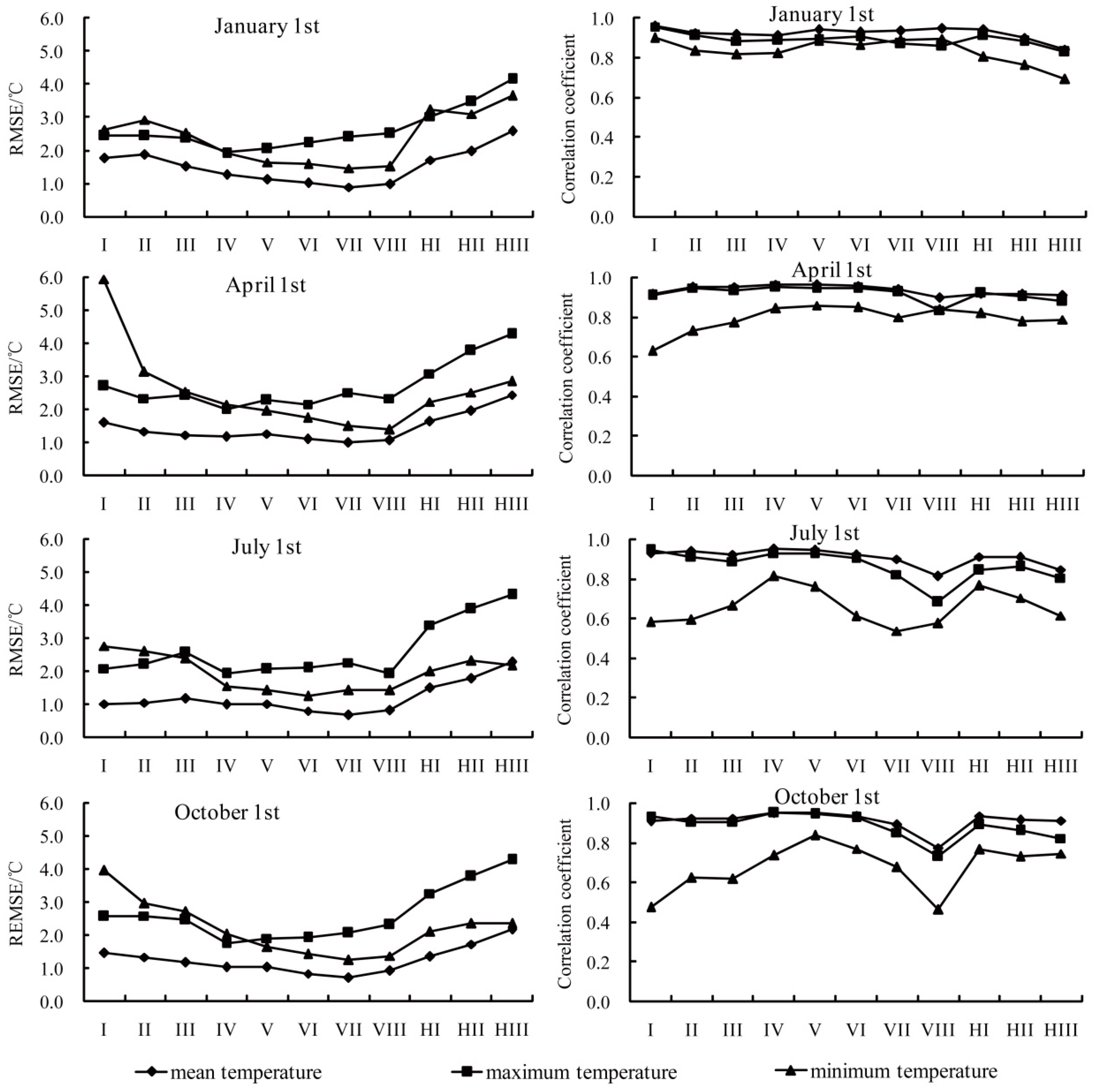

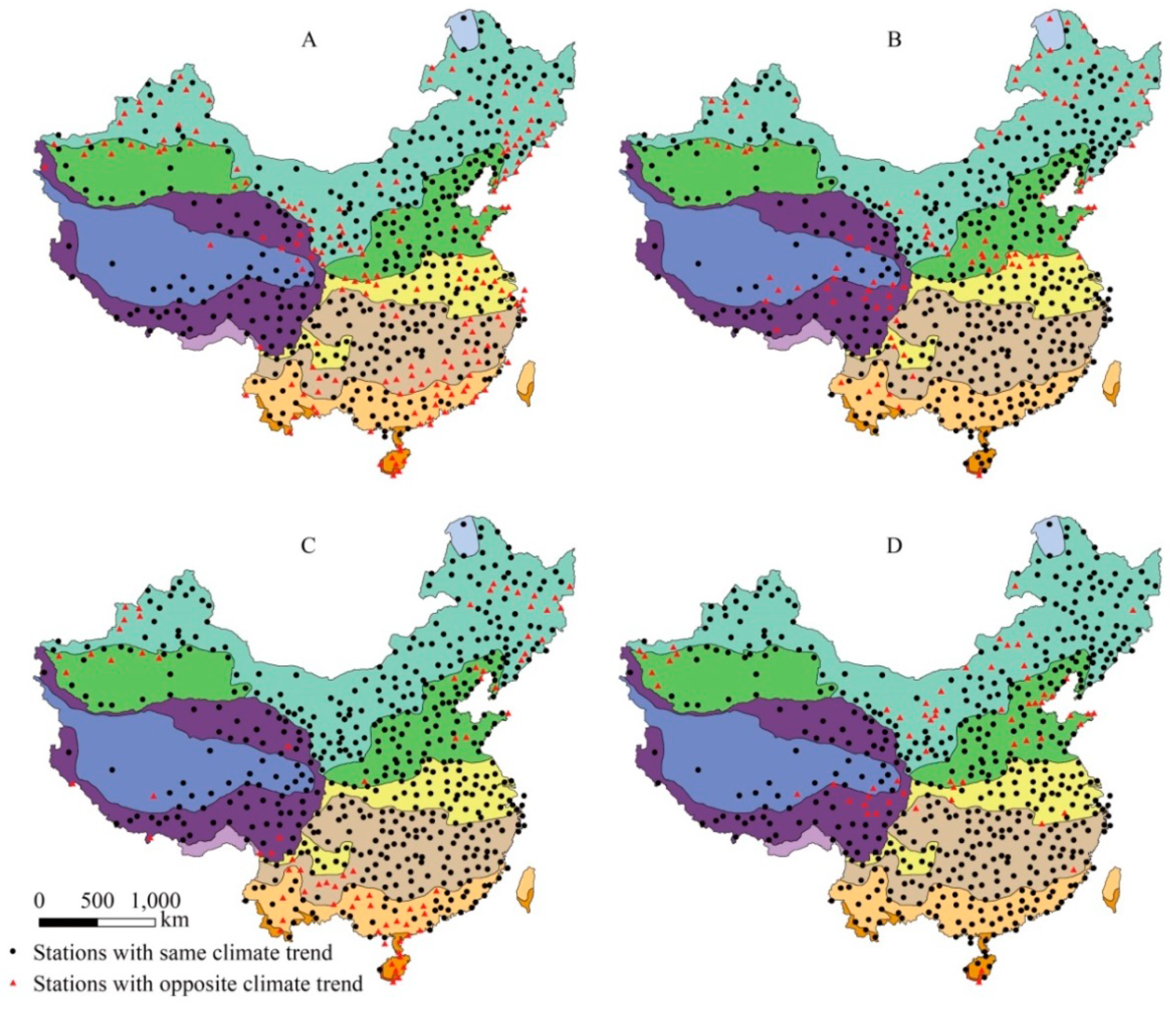
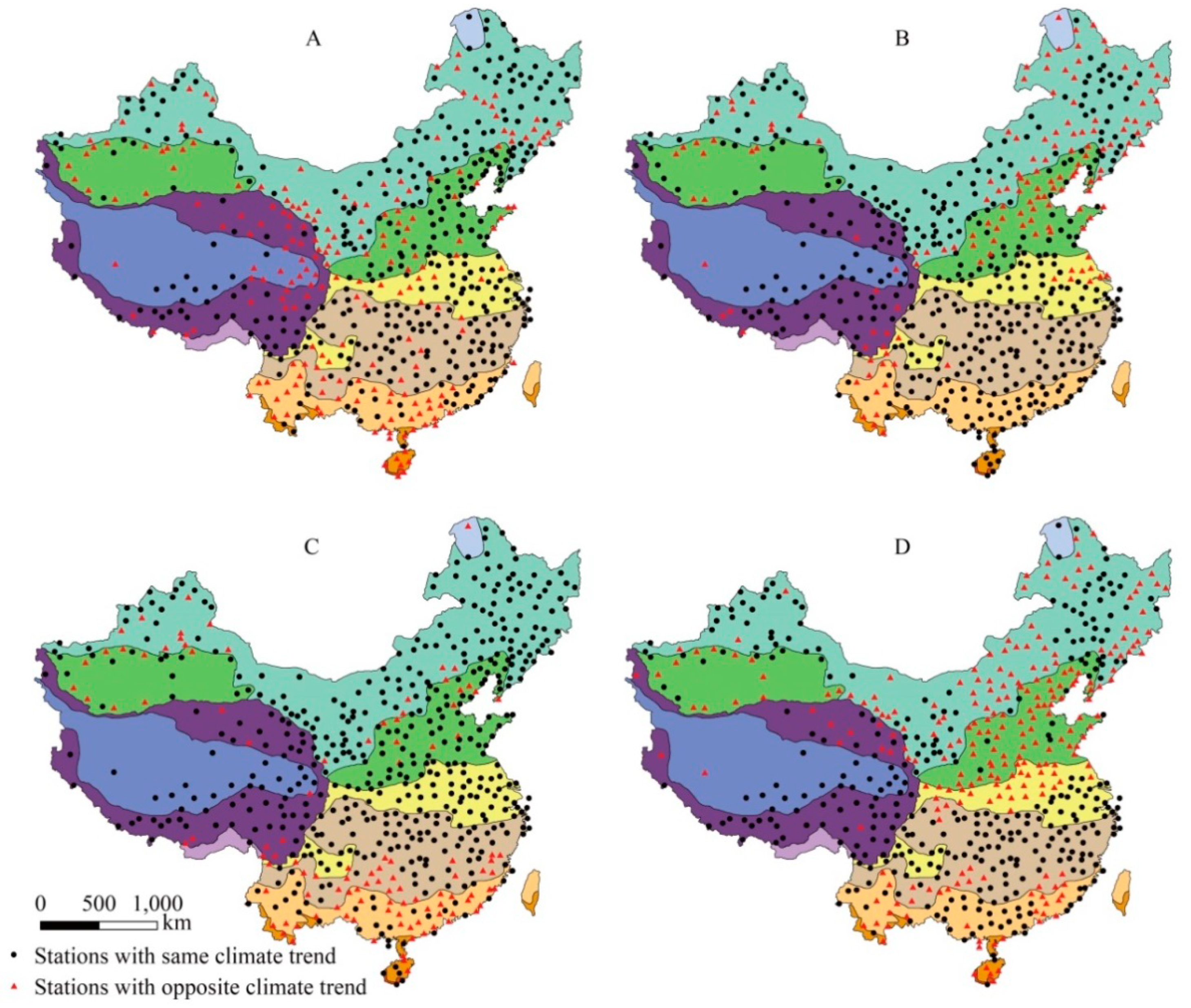
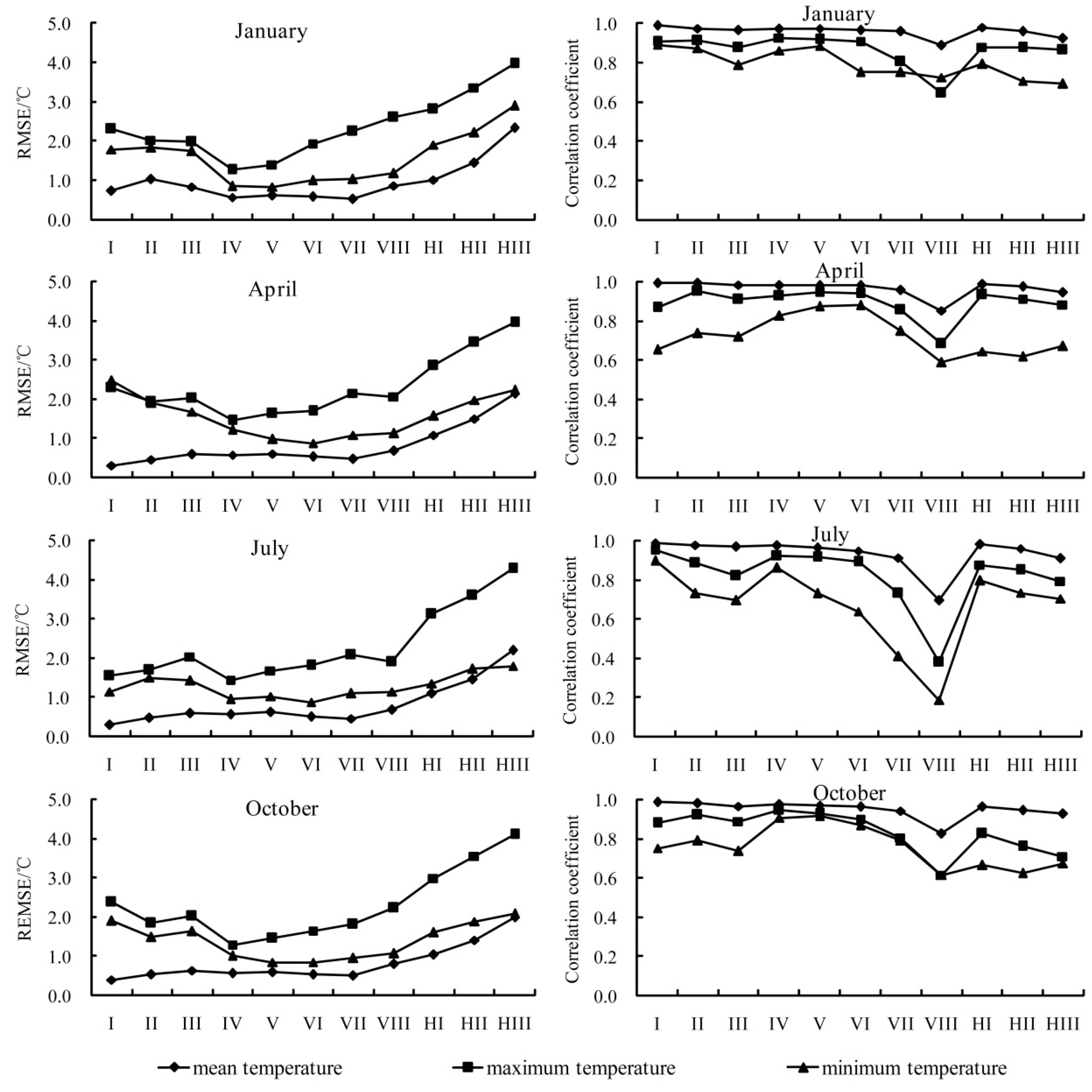
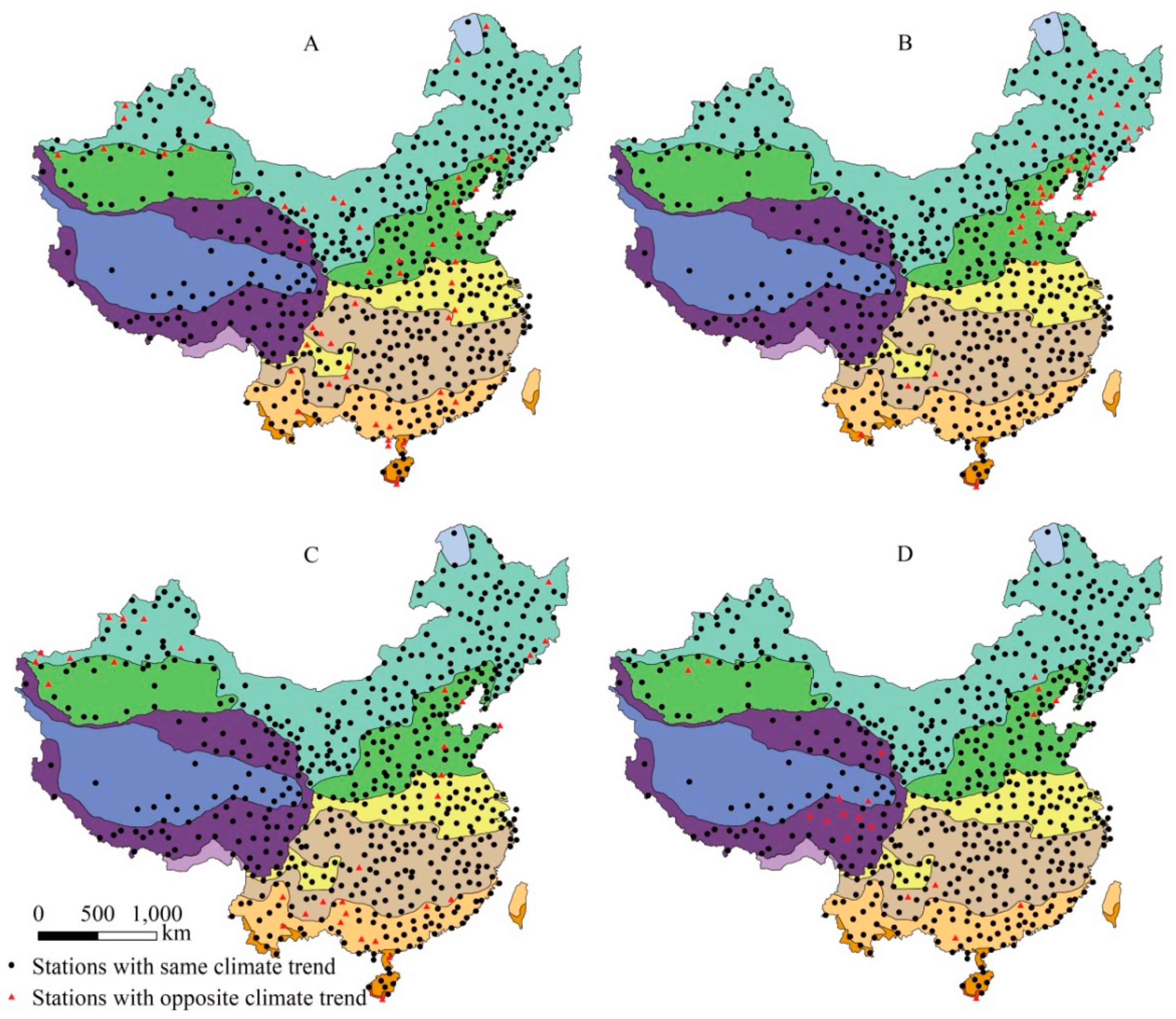
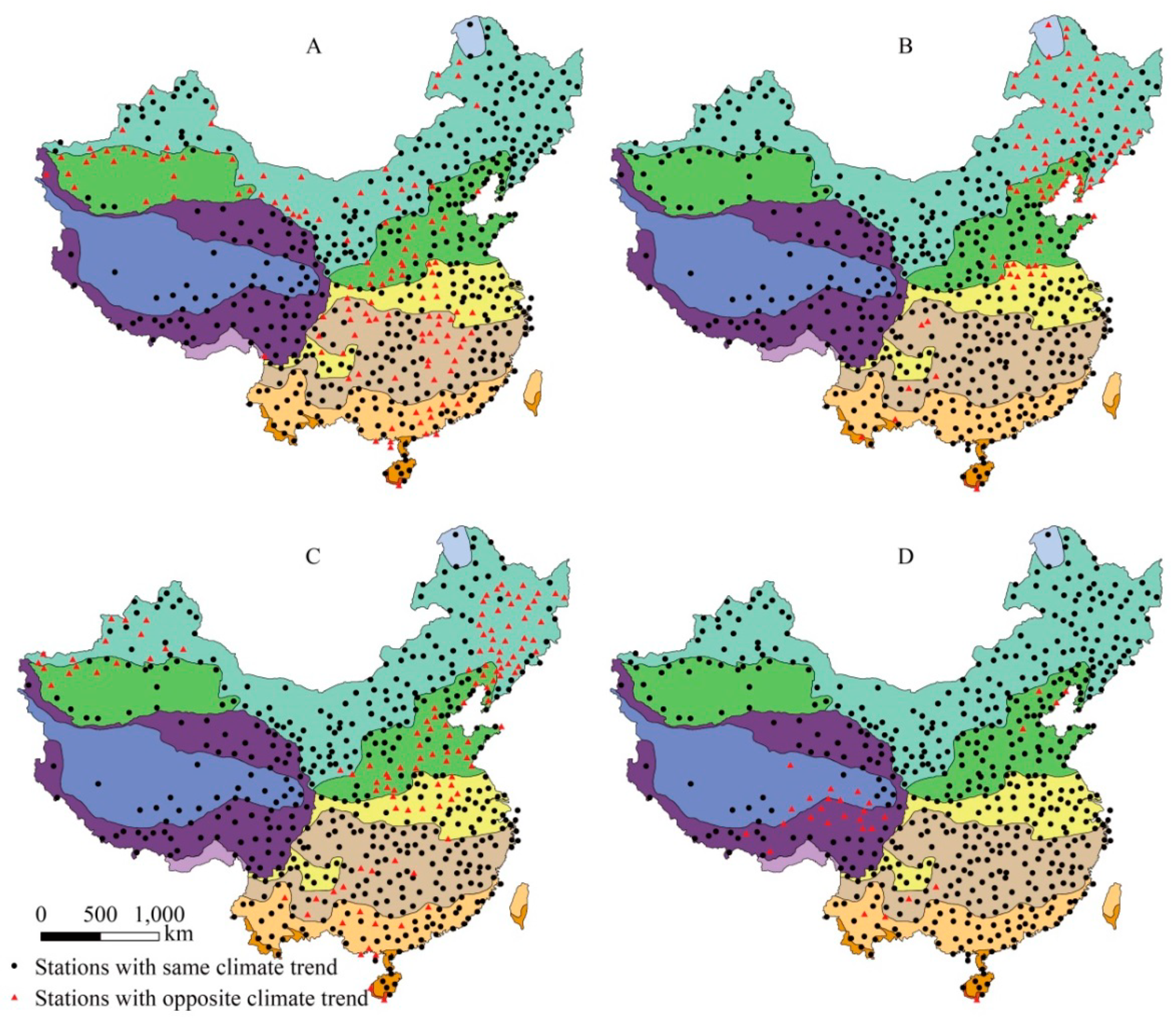
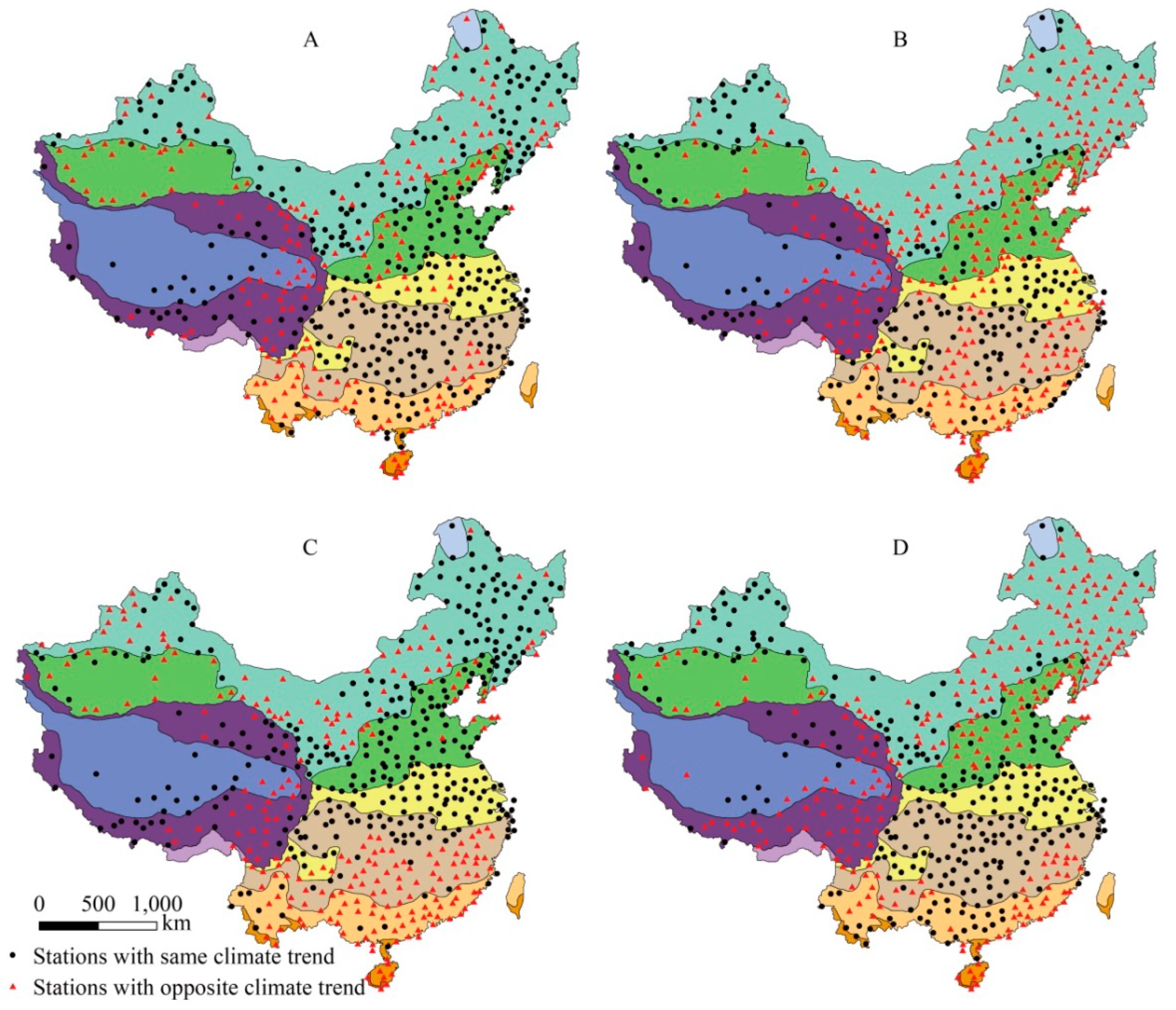

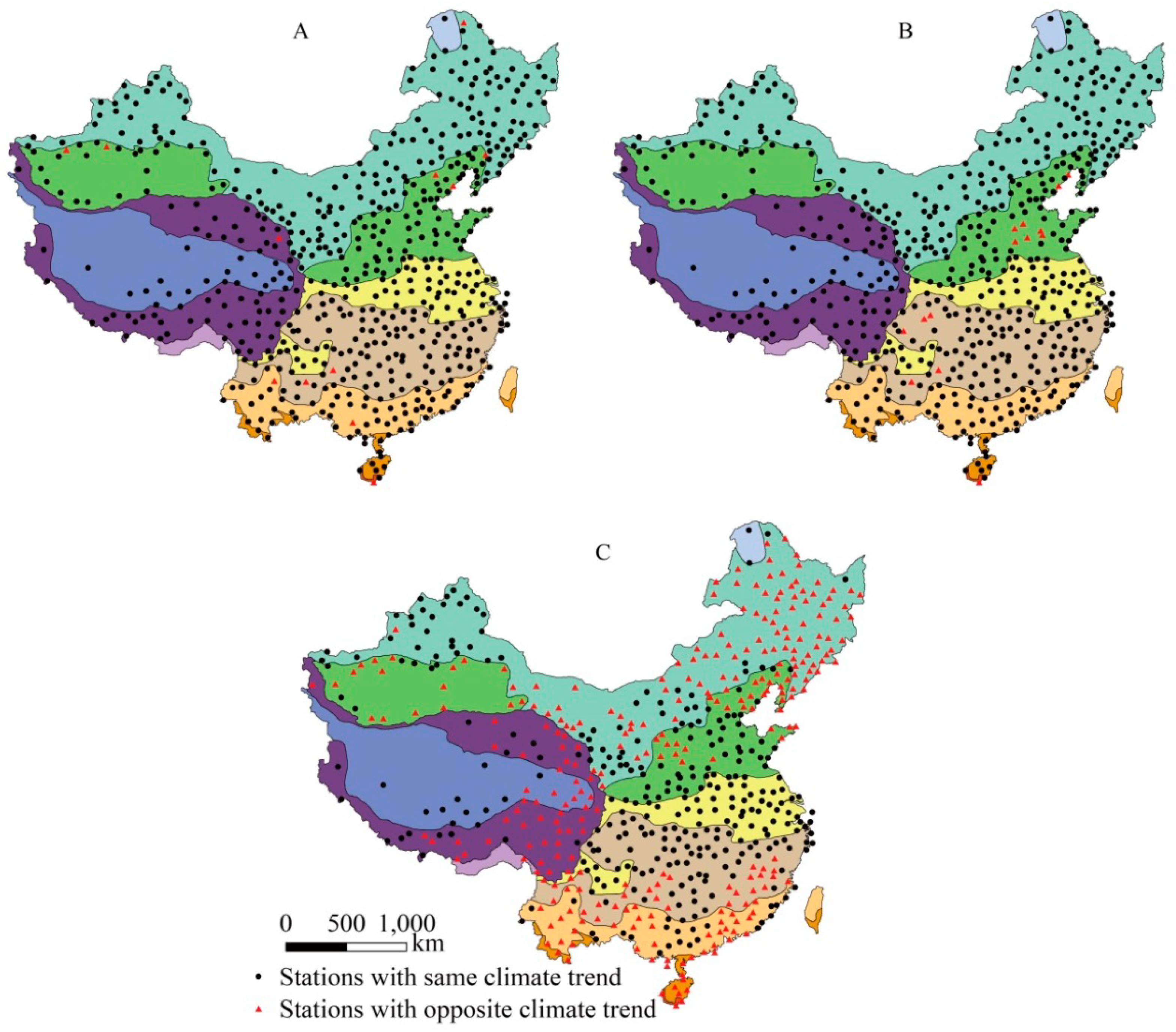

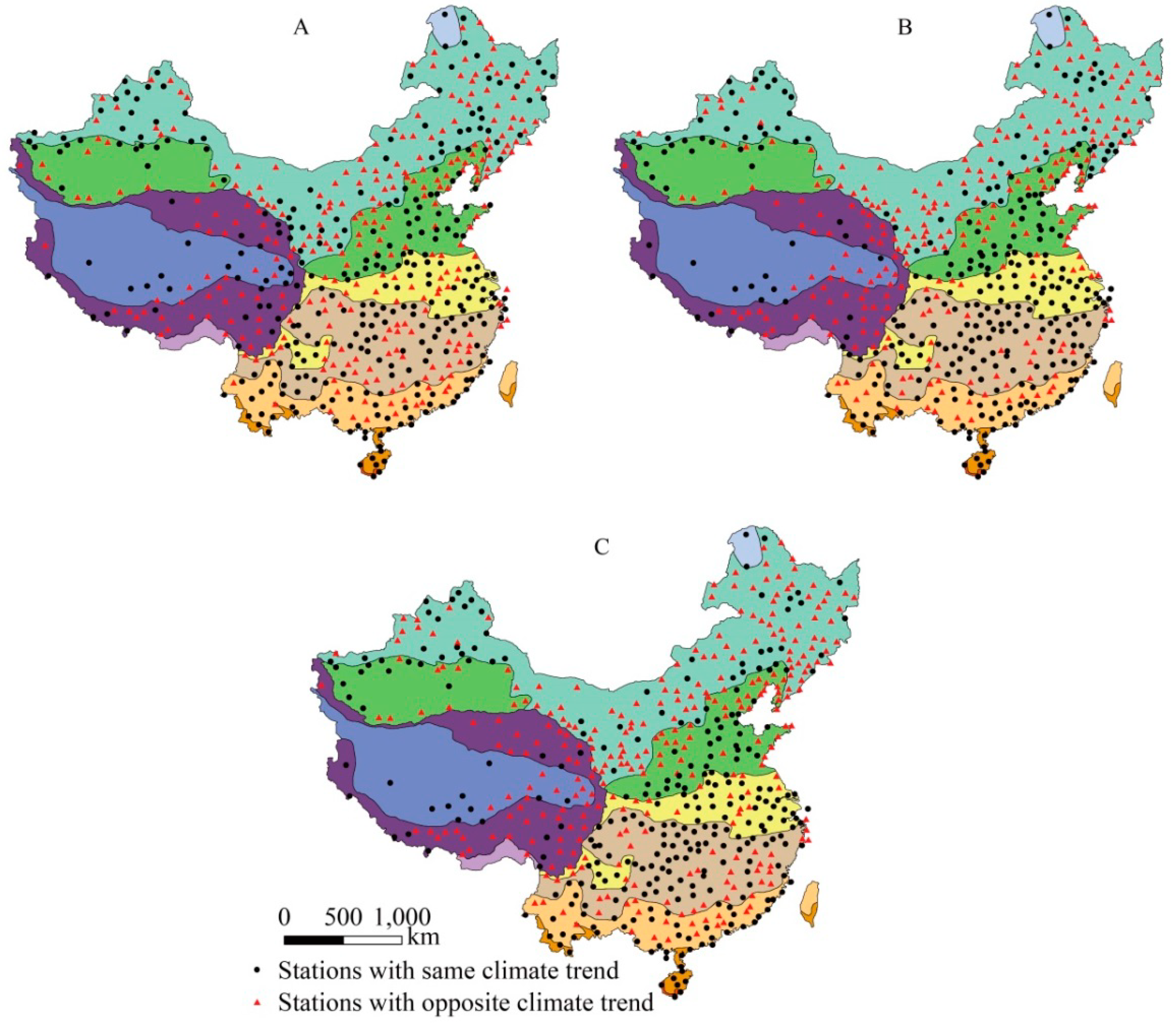

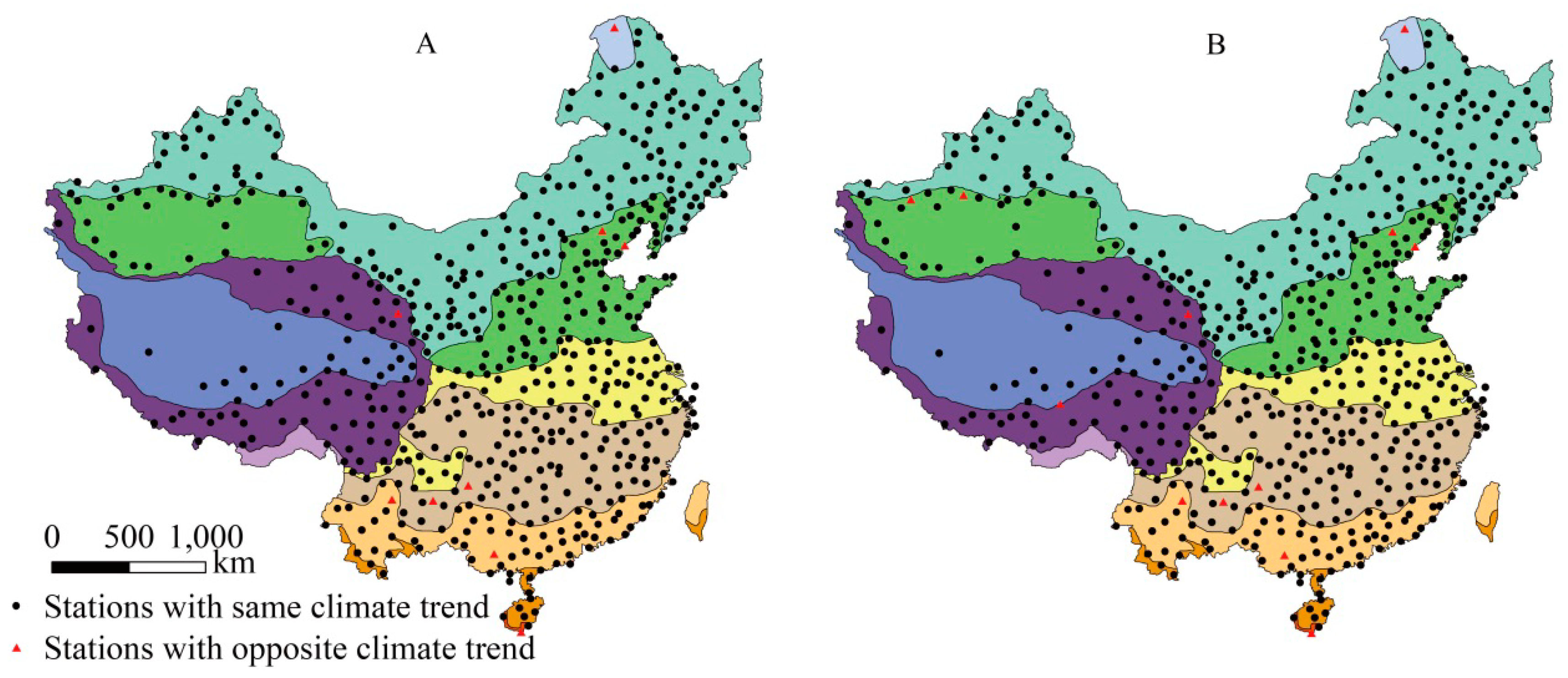
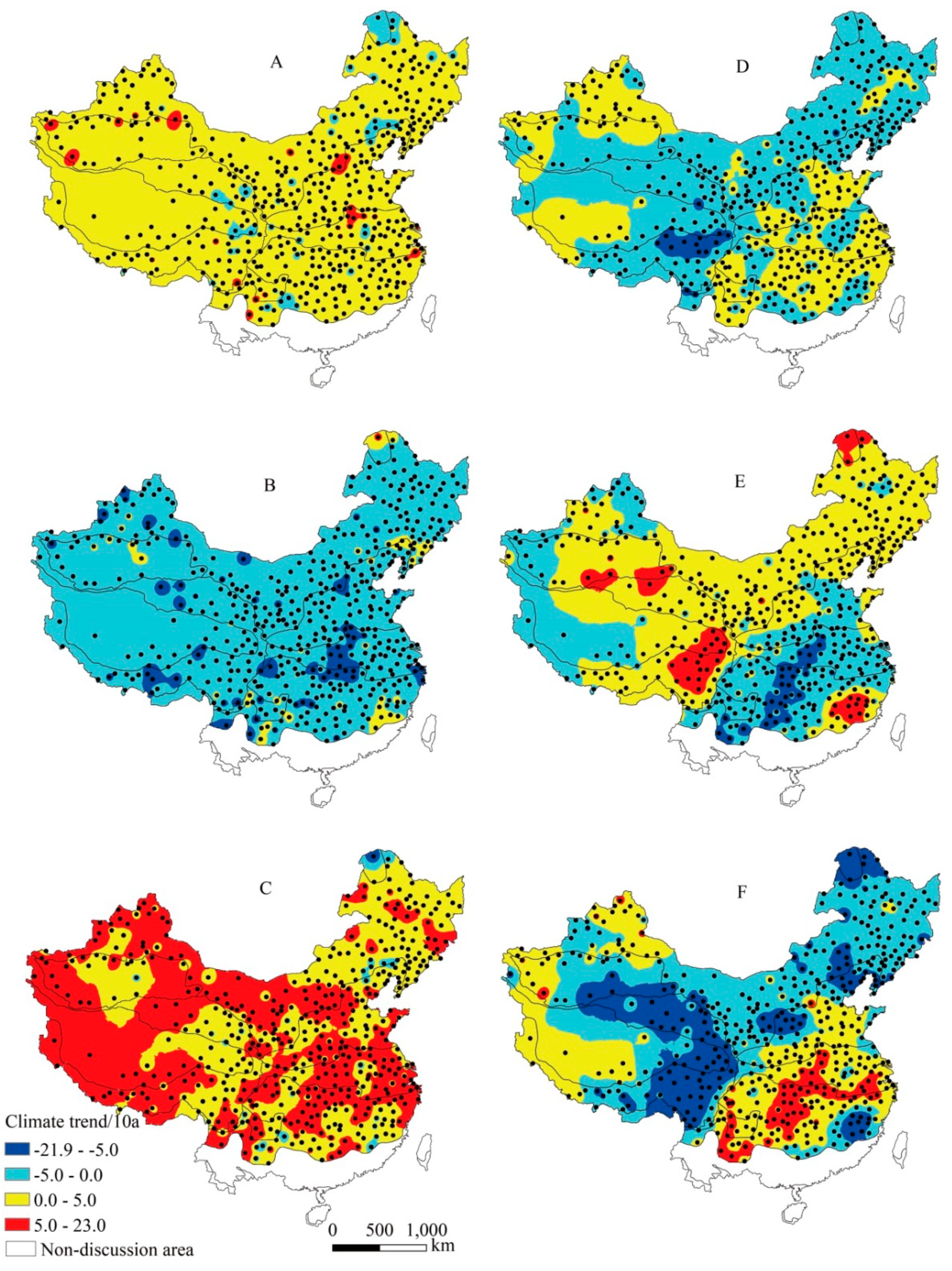
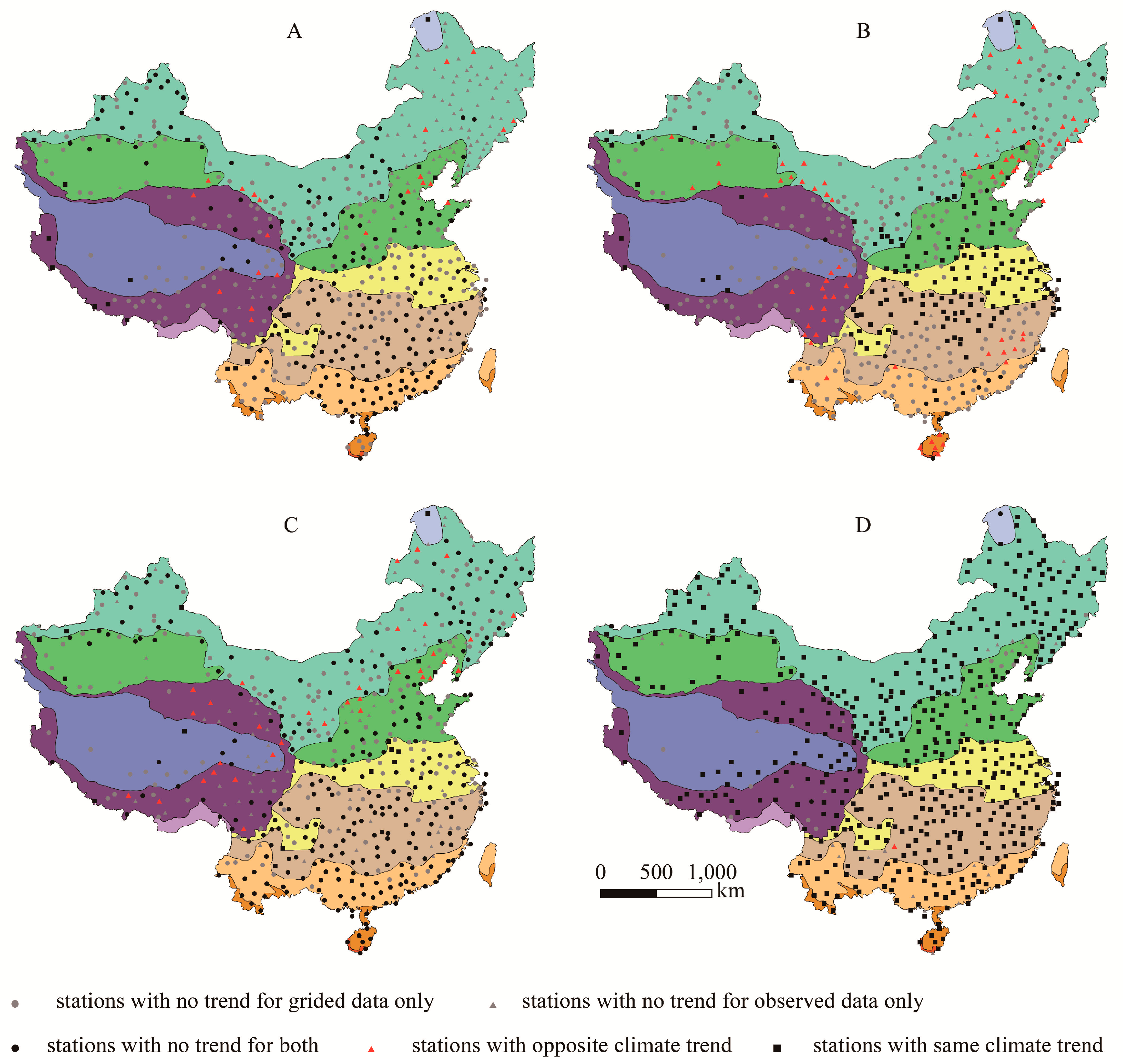
| Date | Daily Mean Temperature | Daily Maximum Temperature | Daily Minimum Temperature | |
|---|---|---|---|---|
| January 1st | The same | 500 (84.7%) | 411 (69.7%) | 384 (65.1%) |
| The opposite | 90 (15.3%) | 179 (30.3%) | 206 (34.9%) | |
| April 1st | The same | 498 (84.4%) | 484 (82.0%) | 439 (74.4%) |
| The opposite | 92 (15.6%) | 106 (18.0%) | 151 (25.6%) | |
| July 1st | The same | 541 (91.7%) | 512 (86.8%) | 479 (81.2%) |
| The opposite | 49 (8.3%) | 78 (13.2%) | 111 (18.8%) | |
| October 1st | The same | 541 (91.7%) | 526 (89.2%) | 345 (58.5%) |
| The opposite | 49 (8.3%) | 64 (10.8%) | 245 (41.5%) |
| Date | Monthly Mean Temperature | Monthly Maximum Temperature | Monthly Minimum Temperature | |
|---|---|---|---|---|
| January | The same | 541 (91.7%) | 463 (78.5%) | 372 (63.1%) |
| The opposite | 49 (8.3%) | 127 (21.5%) | 218 (36.9%) | |
| April | The same | 553 (93.7%) | 493 (83.6%) | 233 (39.5%) |
| The opposite | 37 (6.3%) | 97 (16.4%) | 357 (60.5%) | |
| July | The same | 558 (94.6%) | 469 (79.5%) | 342 (58.0%) |
| The opposite | 32 (5.4%) | 121 (20.5%) | 248 (42.0%) | |
| October | The same | 570 (96.6%) | 561 (95.1%) | 294 (49.8%) |
| The opposite | 20 (3.4%) | 29 (4.9%) | 296 (50.2%) |
| Annual Mean Temperature | Annual Maximum Temperature | Annual Minimum Temperature | |
|---|---|---|---|
| The same | 578 (98.0%) | 576 (97.6%) | 301 (51.0%) |
| The opposite | 12 (2.0%) | 14 (2.4%) | 289 (49.0%) |
| First Frost Day | Last Frost Day | Frost-Free Period | |
|---|---|---|---|
| The Same | 308 (52.2%) | 312 (52.9%) | 286 (48.5%) |
| The Opposite | 282 (47.8%) | 278 (47.1%) | 304 (51.5%) |
| Classification | Minimum Temperature in April | Annual Minimum Temperature | Frost-Free Period | ≥10 °C Active Accumulated Temperature |
|---|---|---|---|---|
| The Same Climate Trend | 3.6% | 27.8% | 3.2% | 90.3% |
| The Opposite Climate Trend | 3.7% | 13.4% | 5.8% | 0.2% |
| No Trend for Both | 39.3% | 4.7% | 48.8% | 0.7% |
| No Trend for Observed Data Only | 19.2% | 4.9% | 14.7% | 6.9% |
| No Trend For Gridded Data Only | 34.2% | 49.2% | 27.5% | 1.9% |
© 2019 by the authors. Licensee MDPI, Basel, Switzerland. This article is an open access article distributed under the terms and conditions of the Creative Commons Attribution (CC BY) license (http://creativecommons.org/licenses/by/4.0/).
Share and Cite
Qiu, M.; Liu, B.; Liu, Y.; Zhang, Y.; Han, S. Evaluating the Accuracy of a Gridded Near-Surface Temperature Dataset over Mainland China. Atmosphere 2019, 10, 250. https://doi.org/10.3390/atmos10050250
Qiu M, Liu B, Liu Y, Zhang Y, Han S. Evaluating the Accuracy of a Gridded Near-Surface Temperature Dataset over Mainland China. Atmosphere. 2019; 10(5):250. https://doi.org/10.3390/atmos10050250
Chicago/Turabian StyleQiu, Meijuan, Buchun Liu, Yuan Liu, Yueying Zhang, and Shuai Han. 2019. "Evaluating the Accuracy of a Gridded Near-Surface Temperature Dataset over Mainland China" Atmosphere 10, no. 5: 250. https://doi.org/10.3390/atmos10050250
APA StyleQiu, M., Liu, B., Liu, Y., Zhang, Y., & Han, S. (2019). Evaluating the Accuracy of a Gridded Near-Surface Temperature Dataset over Mainland China. Atmosphere, 10(5), 250. https://doi.org/10.3390/atmos10050250




